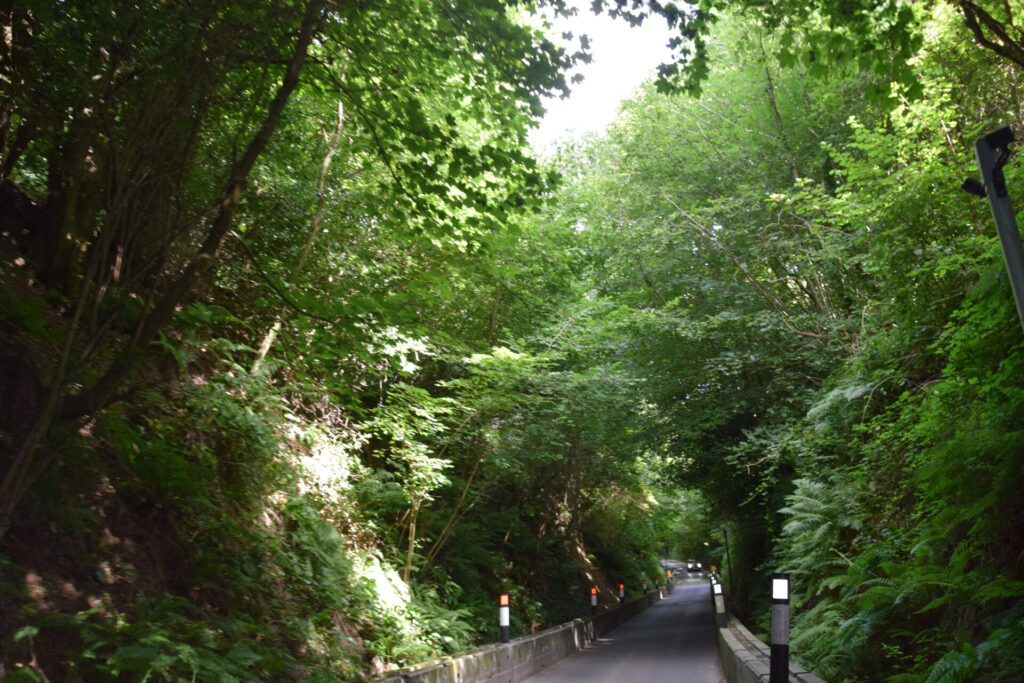Environmental disaster or essential work to avoid a tragedy? Dorset Council’s controversial plans for the road through Melbury Abbas
by Fanny Charles

Dinah’s Hollow is back in the news. Dorset Council proposes to spend £8 million on safety work – felling trees, clearing undergrowth, compulsory purchase orders on adjoining landowners and stabilising the slopes with soil nails.
This week the council’s strategic and technical planning committee agreed the first step: a Tree Works Application to remove trees along the hollow currently covered by a woodland Tree Preservation Order (TPO).
Objectors believe that the holloway is environmentally and culturally important, and home to rare and endangered creatures, including dormice, bats and several red and yellow-listed bird species.
The approval for the tree works will last for five years, much longer than usual, because of the potential delays with the CPOs. It could be three years or more before the stabilisation actually happens (perhaps even longer if there has to be a public inquiry).
The hollow, on the C13 road between Shaftesbury and Blandford, may be a remnant of the ancient forest which once covered this area of the Blackmore Vale: ‘It isn’t just any old holloway,’ says David Webber, chairman of Melbury Abbas and Cann Parish Council, whose family has lived in the area for at least 200 years. ‘And I find it ironic that Dorset Council has just declared a nature emergency.’ (see The BV Aug issue here)
Local MP Simon Hoare supports the need to improve safety for road-users on the C13 and dismisses the argument that Dinah’s Hollow has any particular significance. He says: ‘Ultimately we are not short of pretty ancient lanes and beautiful trees in North Dorset – and in this particular case they are self-seeded, non-specific and rather unremarkable examples.’
You couldn’t make it up.
After the Dorset Council committee meeting on 2nd September was declared null and void because official invitations were not sent to consultees, including the parish council, Cranborne Chase National Landscape and CPRE, the reconvened strategic planning committee meeting, on Monday 30th September, couldn’t start for nearly half an hour due to the fact it was not quorate.
This means that not enough of the possible 15 members of the committee (as listed on the council website) were present for a legal meeting to be held.
The situation was eventually resolved when a substitute was agreed and a quorum was duly established. After that it was relatively predictable – nobody really said anything, and the proposal, controversial as it is, was nodded through. Nobody even asked the question – raised in the report in The BV last month (see here) – raised by local resident Sara Jacson: ‘Why, if as alleged there is potential danger for a serious fall, are we still allowed to drive through the Hollow?’
A member of Dorset Council’s communications team told The BV: ‘The quorum for strategic and technical planning committee is six members, and we had six members in attendance on the committee, five committee members and one substitute. Other members in attendance but not on the committee were councillors Shane Bartlett, Jon Andrews, Simon Christopher, Scott Florek and Jane Somper.’
A deal to be had
Parish council chairman David Webber told the councillors at Dorchester that the geology of the hollow was very different from that at the Beaminster site of a tragic double fatality following the collapse of a tunnel in 2012. The parish council has hired Devon-based Red Rock Geological Sciences Ltd, which has been working with the landowners on a hybrid scheme involving some soil nails and retention fencing. It would cost much less, involve a much shorter period of road closure and very few trees would need to be destroyed.
The alternative A350, which runs parallel to the C13, is a primary route from Poole Harbour, where it is signposted for traffic heading to the motorway network. Between Blandford and Shaftesbury it is currently part of a voluntary one-way system for heavy vehicles – southbound on the C13 and northbound on the A350, through Iwerne Minster, Fontmell Magna and Compton Abbas, with the notorious Steepleton bends and steep Cann Hill near Shaftesbury.
Mr Webber recognises the problems for the A350 villagers and the people in Melbury Abbas. He says once you get over the county boundary into Wiltshire, the standard of the road improves, ‘but Dorset has spent nothing on it,’ he says.
He urged councillors to defer the decision: ‘Please sit down and listen and talk with the principal players.
‘Please do not talk AT them, but work WITH them. It will save a lot of time, money, trees, plants and wildlife. There is a deal to be had.’
Richard Burden, principal landscape officer at Cranborne Chase National Landscape (NL, previously known as an AONB), told the committee: ‘You have been told, correctly, that a TPO is created to sustain tree growth and amenity. How, therefore, does removing 80 trees sustain amenity? As you know, the National Planning Policy Framework guides you to give great weight to conserving and enhancing landscape and scenic beauty, and giving National Landscapes the highest level of protection. Your landscape officer is clear that there would be substantial adverse impacts arising from the tree felling. He then concludes that would not impact on the wider NL. That logic is fundamentally flawed: it would mean the NL could be eroded bit by bit.
‘The test for decision-makers relates to the nature and scale of changes at this specific part of the National Landscape, not locations miles away!’
Mr Burden told the meeting that if the committee did not refuse – or at least defer – the application until further actions to conserve and enhance natural beauty are included, the council would be failing to comply with its duties under the CRoW (Countryside and Rights of Way) Act 2000, which was recently amended. While it did not override the Highways Act 1980, said Mr Burden, the two had to be considered together. ‘That duty is not optional; and current governmental guidance puts Cranborne Chase NL as the initial assessor of compliance.’

A sensible solution
MP Simon Hoare said he had congratulated new Dorset Council leader Nick Ireland for keeping the previous administration’s pledge to keep the Dinah’s Hollow scheme in the capital budget for what he describes as a sensible solution: ‘NOT to do anything is absolutely not an option. The next landslip could easily result in a fatality – and quite aside the human devastation that would cause, the council would be entirely culpable if it hadn’t acted on those reports.’
The problem had been discussed and researched for so long, he said, ‘If there was any chance of a silver bullet, it would have been identified by now.’
He recognised the enormous disruption to residents and commercial operators when either road is closed. ‘But if we want there to be a vibrant, viable economy in North Dorset, our existing road network – imperfect though we all know it to be – must be made fit for purpose.
‘If it were possible, there is little doubt this action would not be the first choice.
But over the last ten years the council has exhausted all options. The only actual solution is an entirely new road – but the economic benefits of a parallel road running to Poole Harbour from the A303 are simply not there. The planning implications cannot be justified, the topography makes it almost impossible and the land ownership tangles as it works through the various SSSIs, National Landscapes etc are unthinkable. On top of all that, the infill development that would be required to justify the spend from the public purse will make a vast swathe of our beloved county entirely unrecognisable.’
It’s gone on too long, says Mr Hoare: ‘We cannot keep twiddling our thumbs, waiting for the perfect solution to magically show up.’
Speed limit and public meeting
Beacon ward councillor Jane Somper says Dinah’s Hollow has never been a party political issue for her: ‘The important point has always been about the local community voices being heard – and the safety of road users.’ She believes a public meeting is needed ‘to give everyone the opportunity to hear the details of what is planned and put their questions to senior council officers.’
While she accepts the need to stabilise the slopes, Cllr Somper says there is also a need for a full understanding of the wildlife present and the steps to mitigate harm to the wildlife and vegetation. Her other major concern is the impact of the works and the closure of Dinah’s Hollow.
‘My focus now will be on the roads that will be most negatively impacted, and the residents I represent, while the works are carried out. It could cause huge disruption and damage to our narrow rural roads, and I have requested that funding be put aside for the repair work that will no doubt be required, along with traffic calming to avoid HGVs meeting at various pinch points along the A350. I will also be requesting a temporary 20mph along a stretch in Fontmell Magna and at other pinch points along the route.’

No benefits
North Dorset CPRE told The BV the villages of Melbury Abbas and Melbury Down ‘will be scarred for many generations. This scheme will come with no benefit to the village or to traffic management within the village, nor increase safety for residents, cyclists or numerous horse riders. The proposed works to the hollow, which is rich in flora and fauna, will neither benefit the biodiversity of the area or provide any environmental gain.’
The countryside campaigns group says that although Dorset Council voted to budget £8m for the Dinah’s Hollow scheme, ‘the actual cost is likely to be considerably higher. No cost benefit analysis has been published, even if one has been carried out. In a time of austerity and tight financial constraints facing councils, this enormous sum could be better spent on more urgent needs such as adult social services. This scheme will also mean an ongoing maintenance cost to the tax payer.’
One of the affected local residents is Mrs Sara Jacson of Grove Farmhouse, who says: ‘It seems that Dorset Council is prepared to spend £8 million pounds on Dinah’s Hollow felling trees and wrecking the undergrowth by aggressive nailing of metal sheeting. The Hollow has been worn by millennia of feet both human and animal: it is not artificially man made. The trees shelter wildlife and their root structure is dense and effective in retaining soil.’
She criticises the impact on trees and wildlife, following the council’s decision to declare a nature emergency. There are no representatives of North Dorset on the new Dorset Council cabinet, she says, so no voice can be raised at that level ‘in protest at this apparent vandalism over which there has been no public consultation.’
Who was Dinah?
Dinah’s Hollow is a holloway – a landscape feature common in Dorset, Somerset and many other parts of Britain. A holloway – literally a hollow way or sunken lane – is defined as a road or track that is significantly lower than the land on either side, not formed by the (recent) engineering of a road cutting but possibly of much greater age. The term ‘holloway’ is thought to come from the Anglo-Saxon word ‘hola-weg’ which means ‘sunken road’; no-one knows how many of these tunnel-like lanes exist throughout Britain.
Theories about how holloways were formed include erosion by water or traffic or digging double banks to mark the boundaries of estates. They are also found in France, Spain and the US, where these ancient routes are called “traces” – one of the best known is the Old Natchez Trace, an ancient corridor originally used by Native Americans, which starts in Mississippi and runs north-east for around 450 miles.
They are typically found in regions with soft terrain, such as the chalk and sandstone areas of southern England, rather than rocky landscapes. Essentially, they are man-made, which is why they have cultural as well as environmental significance – writers and campaigners, including Robert Macfarlane and the environmental arts charity Common Ground, have highlighted their importance. These paths were slowly etched into the landscape through repeated human activity – the passage of countless footsteps and the movement of livestock, shaping these distinctive deep lanes over time.
Shaftesbury, a major hilltop settlement, is surrounded by holloways, of which Dinah’s Hollow is the best known (partly because it has been subject to successive council plans to clear, widen or close it). Among Dorset’s other famous holloways are Shute’s Lane and Hell Lane at Symondsbury, near Bridport – if you’ve never visited it, see the BV’s spectacular walk through Hell Lane here.
No-one knows where Dinah’s Hollow originally got its name (there are also references to Diney’s Hollow and Dinas Hollow). One explanation comes from the late Bob Breach, local historian, former teacher and parish councillor, in an interview on Shaftesbury’s radio station This is Alfred, on 24th May 2021. There are two suggestions, he says – that Dinah was a local whore, or that it is Dina from Dinas, a Celtic name for a road through somewhere (in Cornwall and Wales, dinas can also mean a fort).
Whether the answer is a road or a whore, Bob Breach says: “I wouldn’t like to take a bet!”



